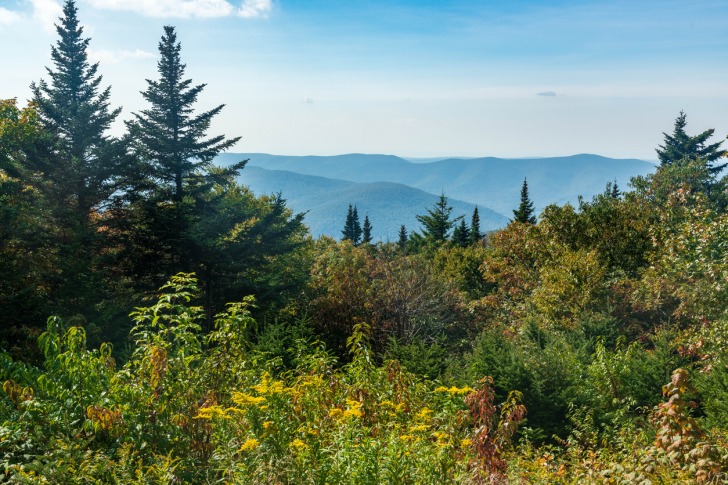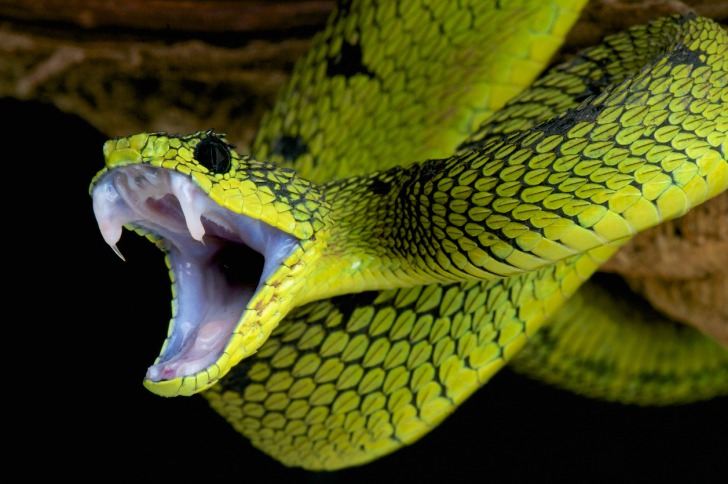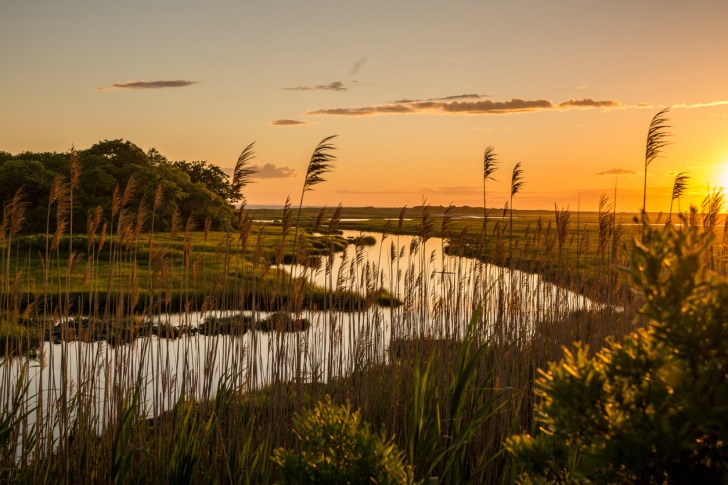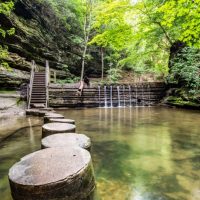If you’re planning a trip or outdoor adventure in Massachusetts and wondering if you should be worried about encountering snakes – this is the guide for you!
Our guide provides an overview of some of the most commonly found venomous and non-venomous snake species currently living in Massachusetts.
Read along to learn how to identify local snake species and which venomous species to steer clear of in the guide below.

Contents
So… Are There Snakes in Massachusetts?
Yes! There are a variety of different snakes in Massachusetts – but there is no real need to worry.
Understanding the local snake species and adhering to common sense outdoor safety tips is the best way to avoid snakebites and unpleasant wildlife encounters when you’re enjoying the outside in Massachusetts.
Snake Species in Massachusetts
One of the most important things you can do is learn about what snake species are known to live in the areas you plan to visit.
The good news is that most of Massachusetts snakes aren’t venomous.
This state is known to be the home of only two venomous snake species.
The guide below provides an overview of some of the most common snakes found in the state along with a link to a comprehensive list.
Learn about the Timber Rattlesnake and the Northern Copperhead snake along with a few other Massachusetts snake species below.
Massachusetts is home to two venomous snakes and a variety of non-venomous snakes.
Local species can be found quietly slithering through nature preserves, forests, and wetlands.
Some species prefer rocky and mountainous areas and can be found perched along cliffsides and sunbathing on rocks.
- Black Rat Snake: The largest snake found in Massachusetts, black with a white throat.
- Dekay’s Brownsnake: Urban, suburban small snake, keeled scales, brown spots.
- Eastern Garter Snake: One of four most commonly seen, long stripes down its body.
- Eastern Hognose: Among larger snakes in the area, mostly black, smooth scales
- Eastern Milk Snake: Turned up nose, body color yellow or brown with keeled scales.
- Northern Copperhead: Venomous, extremely rare, triangular head, cat-like pupil.
- Timber Rattlesnake: Venomous, endangered species, cat-like pupil, heavy body.
View the full list of snakes in Massachusetts here.
Venomous Snake Species in Massachusetts
Massachusetts is home to the Copperhead and Timber Rattlesnake.
Both of these local snake species are currently endangered and local wildlife experts say there are only a few hundred of them left in the area.
- Northern Copperhead Snake: Agkistrodon Contotrix is the proper name of Massachusetts Northern Copperhead Snakes. The Northern Copperhead Snake is a venomous snake known to inhabit rocky and mountainous regions within the state. This snake is identifiable by its earthy brown or orange body, triangular head, and elliptical-shaped pupils which are the hallmarks of venomous snakes found in the region.
- Timber Rattlesnake: The Crotalus Horridus affectionately named the Timber Rattlesnake is the second venomous snake found in Massachusetts. Timber Rattlesnake sightings have become extremely rare. As a result, This highly venomous snake with cat-like pupils and a large body belongs to a protected class of endangered animals covered by the Massachusetts Endangered Species Act.

Is it Safe to Go on a Trek in Massachusetts?
Going on a leisure stroll or a long nature hike in Massachusetts forests and nature trails is relatively safe.
The few venomous snakes that are prone to this region are on the local endangered species list and rare sightings reduce the likelihood of life-threatening snake bites and frightening serpent encounters.
Interesting Snake Facts in Massachusetts
The state snake of Massachusetts is the Eastern Garters Snake.
Both of the venomous snakes found in Massachusetts are in danger of becoming extinct or threatened and are protected from harassment, relocation, or ownership by being on the local endangered species list.
It is illegal to bother, move, transport, kill, or otherwise harass venomous snakes under the Massachusetts Endangered Species Act.
Doing so can land lawbreakers in jail for up to ten days facing fines and penalties of up to $10,000.00.
The Massachusetts Endangered Species Act protects 173 animal species including venomous snakes and 259 plant species which are considered threatened or in danger of extinction.
3 Safety Tips for Exploring Nature in Massachusetts
Tip #1. – Abide by the “Leave No Trace” Rule When Outdoors
The best way to avoid unpleasant encounters with venomous snakes and other dangerous wildlife in Massachusetts is to abide by the “leave no trace” rule.
Leaving no trace means that campers, hikers, bikers, and outdoor workers should not tamper with the natural environment by adding or removing anything that wasn’t there before you arrived.
Keep campsites clean and place all trash and food inside designated receptacles.
Tip #2. – Tampering with Endangered Species is Illegal in Massachusetts
Many of the snake species listed above can be found on Massachusetts threatened or endangered species list.
This means that tampering with snakes, plants, and animals on the list can land hikers, nature enthusiasts, and outdoor explorers in hot water.
Harassing, threatening, relocating, and killing snakes on the state’s endangered species list is against the law.
Tip #3. – Pay Attention to Your Surroundings
Massachusetts visitors should know that local snakes can be found in a variety of rural, urban, and suburban settings.
Most of the snake species found in these areas are non-venomous.
However, nature enthusiasts and people walking through areas where snakes are known to hide out should keep a close eye on their surroundings to avoid close encounters.
Summary
Now that you know more about Massachusetts slithering serpents and where they hang out, you can breathe easier knowing that the likelihood of having a dangerous snake encounter in this area is extremely low.
Even though the chances of suffering from the consequences of a venomous snake bite are slim, outdoor enthusiasts including hikers, bikers, campers, and outdoor workers should remain vigilant when visiting local forests and wetlands as two venomous snakes are living in the region and Massachusetts snakes are known to frequent neighborhoods in suburban and urban areas.
Massachusetts Safety Overview
READ THE FULL REPORT: Massachusetts Safety Review
Safety Index:
- OVERALL RISK: LOW
- TRANSPORT & TAXIS RISK: LOW
- PICKPOCKETS RISK: LOW
- NATURAL DISASTERS RISK: MEDIUM
- MUGGING RISK: LOW
- TERRORISM RISK: LOW
- SCAMS RISK: MEDIUM
- WOMEN TRAVELERS RISK: LOW
Frequently Asked Questions
How many people die from snake bites in Massachusetts?
Not many.
While the CDC and World Health Organization reports show that there are over seven thousand snake bites in the US each year, only five of the bites reported turn out to be fatal.
This means that the likelihood of becoming the victim of a venomous and deadly snakebite in Massachusetts is extremely rare.
Where do Massachusetts snakes like to hide out?
Outdoor explorers stumble upon local snakes almost anywhere in Massachusetts!
Local snakes have been known to hide out in natural settings around the Connecticut River Valley.
Common non-venomous snakes are also found sliding around suburban neighborhoods in backyard gardens, and even in some urban areas.
What is the largest snake found in Massachusetts?
The Black Rat Snake is the largest snake found in Massachusetts.
This non-venomous snake can grow to be longer than one hundred inches and can be identified by its keeled scales and mostly black body.
Juvenile snakes of this variety can also appear as a mottled grey.
Nature lovers should note that these snakes are generally found in or near the Connecticut River Valley.











